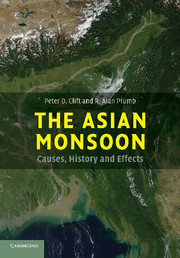Book contents
- Frontmatter
- Contents
- Preface
- Acknowledgements
- 1 The meteorology of monsoons
- 2 Controls on the Asian monsoon over tectonic timescales
- 3 Monsoon evolution on tectonic timescales
- 4 Monsoon evolution on orbital timescales
- 5 Erosional impact of the Asian monsoon
- 6 The Late Holocene monsoon and human society
- References
- Further reading
- Index
- Plate section
2 - Controls on the Asian monsoon over tectonic timescales
Published online by Cambridge University Press: 01 September 2009
- Frontmatter
- Contents
- Preface
- Acknowledgements
- 1 The meteorology of monsoons
- 2 Controls on the Asian monsoon over tectonic timescales
- 3 Monsoon evolution on tectonic timescales
- 4 Monsoon evolution on orbital timescales
- 5 Erosional impact of the Asian monsoon
- 6 The Late Holocene monsoon and human society
- References
- Further reading
- Index
- Plate section
Summary
Introduction
As described in Chapter 1 the intensity of the modern Asian monsoon can be understood as being principally a product of the seasonal temperature differences between the Indian and Pacific Oceans and the Asian continent. It is these differences that drive wind and weather systems in the strongly seasonal fashion that characterizes the climate throughout South and East Asia (Webster et al., 1998; Figure 2.1). As a result, the long-term history of the Asian monsoon would be expected to extend as far back in time as the assembly of these major geographic features themselves, i.e., to the construction of Asia as we know it, following collision of the Indian and Asian continental blocks, generally presumed to be around 45 to 50 Ma (e.g., Rowley, 1996). Even the youngest estimates place the final collision of India and Asia at no younger than 35 Ma (Ali and Aitchison, 2005; Aitchison et al., 2007).
Monsoon weather systems are not unique to Cenozoic Asia. Monsoon climate systems have been recognized in ancient supercontinents, such as Pangaea, where similar major temperature differences existed between land and ocean (e.g., Loope et al., 2001). Indeed, even before the collision of India and Asia there must presumably have been a monsoon system operating between the Tethys Ocean in the south and Eurasia in the north. However, the intensity of that system would have been low because prior to the Indian collision Asia was somewhat smaller and less elevated than it has been for most of the Cenozoic (Wang, 2004).
- Type
- Chapter
- Information
- The Asian MonsoonCauses, History and Effects, pp. 29 - 48Publisher: Cambridge University PressPrint publication year: 2008

